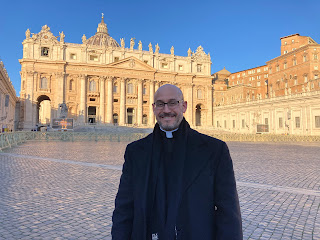A tour of plazas and fountains (January 12)
The Spanish steps and the Piazza de Spagna
Column and monument commemorating the Immaculate Conception. The Holy Father comes here each December 8 to pray and to place a wreath of flowers on the statue of Our Lady.
Trevi Fountain in the Piazza di Trevi. The fountains of Rome are where the ancient aqua ducts built by the Romans come to the surface to provide drinking water to the city. The tradition of throwing thee coins in the fountain to come back to Rome comes from the Roman soldiers making sacrifices to the god of the river for safe travel and to return home to Rome.
Piazza di Pantheon
The Pantheon, built as a cylindrical domed temple to "All the gods", is a very unique structure. There are no other round temples in the ancient world. Modern science and engineering are still trying to determine how the building has remained intact after more than 2000 years. Now the Pantheon is a church dedicated to Mary and All the Martyrs. Michelangelo studied the Pantheon and used it as a model when designing the dome for St. Peter's Basilica.
Piazza Minerva
The Romans were fascinated with Egyptian culture and brought back from Egypt many obelisks. There are more obelisks in Rome (11) than in any other city. There is an obelisk in front of every major basilica. The shortest obelisk in Rome is in the Piazza Minerva in front of the church of Santa Maria Sopra Minerva. Santa Maria Sopra Minerva was built over ("sopra") an ancient temple to the god Minerva. This church is the only remaining church in Rome built in the gothic style. This church is run by the Dominicans and is where the body of St. Catherine of Siena is entombed. Here are some interior pictures of the church:
I offered Mass in this side chapel
The nave of Santa Maria Sopra Minerva
A statue of Christ the Savior by Michelangelo












Comments
Post a Comment